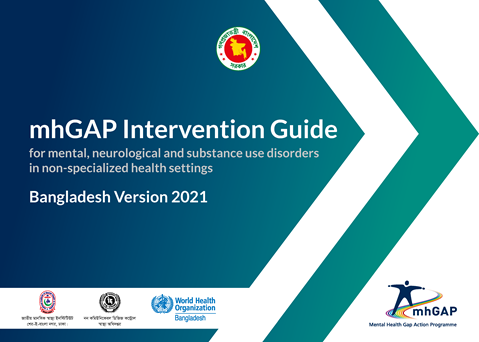mhGAP Intervention Guide for mental, neurological and substance use disorders in non-specialized health settings
Bangladesh Version 2021

Overview
According to the National Mental Health Survey, Bangladesh 2018–19, conducted by the National Institute of Mental Health, Bangladesh, with technical guidance from the World Health Organization (WHO), 16.8% of adults and 14% of children (aged 7–17 years) in Bangladesh suffer from psychiatric disorders. However, among those affected, 92.3% of adults and 94.5% of children do not access mental health services. There is less than one psychiatrist for every 700,000 people. It is evident that relying solely on specialists to provide services for people affected by mental, neurological, and substance use (MNS) disorders prevents millions from accessing the care they need.
The mhGAP approach provides interventions for the prevention and management of priority MNS conditions, identified based on evidence of effectiveness and feasibility for scale-up in low- and middle-income countries. Priority conditions were selected because they represent a high burden (in terms of mortality, morbidity, and disability), result in large economic costs, or are associated with human rights violations. These include depression, psychoses, mental and behavioural disorders in children and adolescents, disorders due to substance use, self-harm/suicide, epilepsy, and dementia.
The target user group of mhGAP-IG is non-specialized healthcare providers working at first- and second-level healthcare facilities. These providers include primary care doctors, nurses, and other members of the healthcare workforce. Although mhGAP-IG 2.0 is designed primarily for non-specialists, mental health specialists may also find it useful in their work.
The mhGAP-IG Bangladesh version 2019 begins with Essential Care and Practice, a set of good clinical practices and general guidelines for healthcare providers’ interactions with people seeking mental health care. All users of the mhGAP-IG should be familiar with these principles and follow them as closely as possible.
The mhGAP-IG also includes a Master Chart, which outlines common presentations of priority conditions and emergency presentations of priority MNS conditions, guiding clinicians to the relevant modules. The most serious conditions should be managed first.
